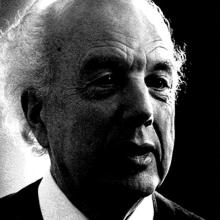
Kurt Jooss
When creating his ballets, the German choreographer Kurt Jooss (Wasseralfingen, 1901-1979) set himself no easy task. He wanted to capture the essence of each individual emotion in a specific movement, to make it absolutely clear to the audience what the dancer was feeling at that moment. Jooss summed up his style concisely as ‘essentialism’. He often ‘froze’ movements for a moment, like taking a photo, thus etching them onto the memory, as it were. But possibly even more important is the way Jooss blended two different dance styles: classical, abstract ballet technique and the hyperexpressive gestures of German Ausdruckstanz – long before concepts like ‘fusion’ and ‘cross-over’ came into being.
Jooss studied piano, singing and drama at the conservatoire in Stuttgart, where he met choreographer and dance theorist Rudolf von Laban, with whom he studied from 1920. Later, he became a dancer and assistant with Laban’s company. Jooss received his first appointment as ‘movement director’ at the Stadttheater, in Münster, where he formed his first company, Die Neue Tanzbühne, along with colleagues Aino Siimola (who later became his wife) and Sigrid Leeder, composer F.A. Cohen and designer Hein Heckroth. Leeder and Jooss went on tour with the programme Zwei Tänzer and they both studied classical ballet in Paris and Vienna.
In 1927, Jooss moved to Essen, where he co-founded the Folkwangschule (a performing arts academy) and directed the dance department. He reformed his own company, which then became the resident company of the opera house in Essen. His ballet The Green Table – nowadays generally regarded as one of the highlights of twentieth-century dance history – won first prize at the Concours de Les Archives Internationales de la Danse de Paris, in 1932. Shortly afterwards, he was forced to leave Germany for political reasons. His whole dance company followed him to Dartington Hall in England, where he founded the Jooss-Leeder School of Dance in 1934. In the years that followed, he went on numerous international tours with his company, which was rechristened Ballets Jooss. In 1949, Jooss returned to Germany as a British citizen to rebuild the Folkwangschule and form a new dance company. One of his pupils during this period was Pina Bausch, who was later to become Germany’s most famous female choreographer.
Up to his retirement in 1968, Jooss worked as a director, choreographer and teacher. In the 1960’s, he finally consented to the many requests from international companies to be allowed to perform his work. In the rehearsals, he was assisted by his daughter, Anna Markard, who took over the task after his death and carried on until her own death in 2010. Nowadays, Jooss’ magnum opus, The Green Table, is taught and rehearsed all over the world by Jeanette Vondersaar, former principal dancer with Dutch National Ballet.
During Shadows, the opening performance of Dutch National Ballet's 2022-2023 season, Kurt Jooss his choreography The Green Table was performed.